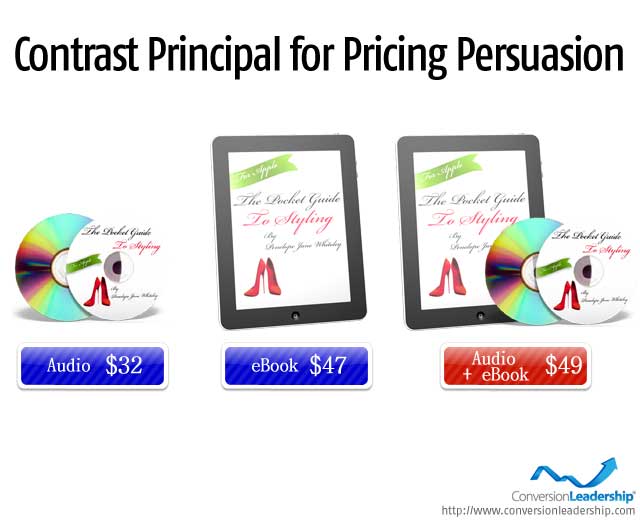5 Upselling Techniques to Increase Average Dollar Sale

With the shift to online sales, though, it seems like many businesses have forgotten how to use upselling techniques.
Up-selling has been with us for a while; it's one of the most popular strategies of large multinational organisations like McDonalds and Apple.
Five of the Best Upselling Techniques we know about
If you're happy with your conversions but want to boost your sales, try these five great techniques.
Upselling Technique #1: Packaged & Priced to Persuade
The classic example and perhaps the most common of upselling techniques has been used for selling books online and works where ever you have a product that's available in multiple formats. Here's how it works...
You sell the printed version of your book at it's usual retail price let's say $39.95, you also sell a downloadable version of book as an eBook edition at $9.95. Then you put together a bundle where you can buy both the printed and eBook for a marginally higher price than the printed book alone, let's say $42.00.
The psychology behind the buying decision changes when there is a third option presented. Instead of deciding on price between $9.95 and $39.95. The decision now becomes between the printed book on it's own at $39.95 or the one with the eBook as well at $42.00.
If you're a follower of Robert Cialdini, you'll recognise this as an application of the Perceptual Contrast principal.

Upselling Technique #2: People Who Bought This Also Bought
Sticking with persuasion and influence, this next of the big upselling techniques comes from the principal of Social Proof also known as Informational Social Influence.
Simply by making it known that something is popular among people that are your customers other people who believe themselves to be like your existing customers are more inclined to purchase.
We like people we are like... and the emotional logic follows that what they like we like
This strategy is used in the fashion industry to great effect. When actresses and actors appear on the red carpet at award ceremonies we get told the name of the designer who's clothing they are wearing. This isn't just for vanity, the designers make sure this happens so that all those fans who like a particular actor or actress will be persuaded to desire the clothes they are wearing.
Amazon.com have also increased the persuasion stakes by having user contributed reviews and scoring on products they sell as additional subtle self-persuading tools to get you to buy even more.
Upselling Technique #3: Take Shipping Out of The Decision
Removing the cost of shipping from the transaction removes one of the barriers to buying, allowing shoppers to consider purchasing without concern about weight or package dimensions. This means that they're focused entirely on the individual items and their affordability compared with other items on your website (once they've determined that you have the exact item they want).
Taking away the shipping cost from the buying decision is one of the less frequently practiced upselling techniques among E-commerce providers but very, very effective. Doing this gives you a higher probability of winning over the customer, particularly if there is more than one item they want to purchase and you are able to make at least one of these items less expensive than buying it in a separate transaction.
While you're not explicitly bundling items together, your buyer is mentally doing these sorts of calculations all the time.
When buying online, customers want to maximise the value they get out of the transaction. This doesn't just mean the cheapest price or most features, but the most effective shipping deal, the least amount of hassle receiving the purchase or getting as much of what they want in one transaction/delivery/handing over of their details.
When you make it evident that this is how buying from you works, the number of items per transaction will increase as will your average dollar sale.
Upselling Technique #4: Shift the Pricing Focus
This is sometimes one of the most deceptive upselling techniques used by businesses when it comes to increasing the total spend in a transaction.
The computer games industry have been fabulous at doing this; bringing the price of games consoles down to an incredibly affordable level but then making money on the games software.
By separating out the games from the consoles, games companies were able to create a scenario where one was useless without out the other. The console alone is pointless, just like having games cartridges are useless unless you have a device to play them on.
By modularising your products in this sort of way, so that the fullest functional product can only be achieved through multiple items being bought, gives you greater potential for pricing shift as well as the introduction of new or more accessories and services.
Even now with online games, the industry makes fantastic revenues from in-game sales. That means instead of paying a high price to play the game, the price has shifted and you now pay to improve your enjoyment of playing the game through buying customisations and virtual goods.
When you are able to shift the focus on pricing so that it becomes a completely different decision... like - what features do I want or need, then the size and total value of the transaction becomes irrelevant.
This last item isn't so much an Up sell technique as a reminder that persistence pays
Upselling Technique #5: Follow-up & Follow-through
Most businesses will follow up with a post sale thank you message, few follow through with another offer straight after the sale.
With broadcast marketing - TV and radio you needed to be careful about saturation... how many times you scheduled your message so that you make an impression and not annoy the audience. In the world of Internet Marketing you also broadcast as often as your audience will tolerate via email, social media, blogging, pay per click etc.
As sad and unfortunate as this may sound to you personally; your audience/the people in your email list, your social media followers and the general public on the Internet today have come to expect many messages from you once you know about them.
They follow up with email messages frequently - always making you aware of what ever offer they have running (and they always have some new offer - new season, latest colours, new range, special discounts, sale items, mystery gifts, free delivery days and a whole host of other reasons why they're emailing you).
From their strategy it's clear that EziBuy strongly believe that once you've bought from them once you will buy more from them again, so they position their marketing message from this stance. Far from being apologetic about getting in touch "so frequently", this company goes out of it's way to give you every opportunity possible to buy from them whether by mail with the catalogue form, over the phone on their free call 1800 number or online via their website. Even when your purchase arrives... they include another catalogue as well as forms for you to order more and fax back.
Upselling The Magic Solution...
The reality is, applying upselling techniques are lot more complicated and a lot less formulaic than you may desire or expect.
Few businesses consider the Follow-up & Follow-through tactic as appropriate for their brand. Often because they have some notion that people don't want to be bothered by "so much marketing", and by doing this they will damage their brands reputation.
Without making some changes and testing & measuring how can you KNOW that what you think/feel/believe is really true?
What is absolutely undeniably true though, is that unless you ask for the extra sale, you'll never make the extra sale.
So if you're reluctant in anyway about over marketing or selling too hard, do what we always recommend here on Conversion Leadership - test and measure.
Implement one of these techniques and measure the results. Don't know what to measure? Ask yourself...
- Did we get a lift in the average dollar sale?
- Did we lose sales or customers?
- What happened to overall conversion rates?
- Did we get more returns?
- Did we get more unsubscribes?
- Who complains and who doesn't?
- What did they buy and how much did they spend with us?
- What's the lifetime value of a customer now?

